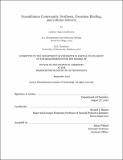Guanidinium Compounds: Synthesis, Oxoanion Binding, and Cellular Delivery
Author(s)
Orgren Calabretta, Lindsey
DownloadThesis PDF (13.40Mb)
Advisor
Raines, Ronald T.
Terms of use
Metadata
Show full item recordAbstract
The delivery of biological molecules into cells has been an issue of importance in both chemical biology and drug discovery. One method used to transport biologics into cells is the cellpenetrating peptide (CPP). This arginine-rich peptide forms strong interactions with the cell surface through bidentate guanidinium–oxoanion hydrogen bonds. Depending on conditions, this interaction guides the uptake of the CPP and its cargo through direct translocation or endocytosis.
In Chapter 1, I summarize literature that is relevant to this thesis.
In Chapter 2, I describe the synthesis and characterization of a small molecule, 1- guanidino-8-amino-2,7-diazacarbazole dichloride (GADAC), that displays a high binding affinity to a carboxylate, phosphate, and sulfate in water. GADAC is also fluorescent and displays an increase in quantum yield mediated by pH. The uptake and fluorescence of GADAC is observed in human melanoma cells via epifluorescent microscopy. Thus, the GADAC scaffold shows promise as a potential cell-uptake promoter and fluorescent reporter of biologics.
In Chapters 3 and 4, I explore alternative amino acids for use in CPPs. I studied the ability of canavanine, a δ-oxa-analog of arginine, to partition into octanol in the presence of anionic lipids as a proxy for its cell-penetration ability. I observed that canavanine is worse at partitioning than arginine, indicating it may not be an effective CPP alternative.
In contrast, I synthesized and performed anion-mediated partitioning on Nα-methylated arginine derivatives and observed increased octanol uptake compared to unmethylated arginine. This increased uptake is correlates with a decrease in topological polar surface area (TPSA) and indicates that an Nα-methylated CPP could be a cell-uptake promoter with increased efficacy.
Lastly, in Chapter 4, I describe the synthesis of biaryl-bisguanidines. These guanidines are inspired by axially constrained organometallic catalyst ligands and have applications in oxoanion binding as dications and organometallic catalysts as dianions. I detail initial forays into determining the binding affinities of the guanidines to oxoanions through NMR titration experiments, which were hampered by changing ionic strength of the solutions.
Appendices describe the synthesis of photocaged phosphinothioesters for the traceless Staudinger ligation and attempts to install a diazo moiety site-selectively at the N-terminus of a peptide or protein.
Date issued
2022-09Department
Massachusetts Institute of Technology. Department of ChemistryPublisher
Massachusetts Institute of Technology